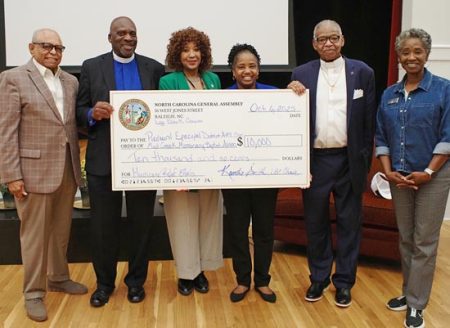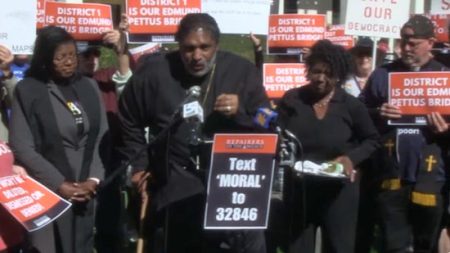Voting History and Ideals Collide in North Carolina Primary

By Nelda Holder –
There is a long shadow across the March primary in the state of North Carolina.
Although its source goes back much further, its current shape began fifty-one years ago with the passage of the federal Voting Rights Act in 1965. That law, designed to ensure voting rights for minorities in the wake of egregious state restrictions, established a method called “preclearance” in certain states or jurisdictions with a heavy history of voting discrimination against minorities.
Any jurisdiction under the preclearance requirement’s coverage formula (which was periodically updated) had to have any changes affecting voting approved in advance of implementation (“pre-cleared”) by either the U.S. Attorney General or the U.S. District Court for D.C., verifying that the change did not discriminate against protected minorities. Forty of NC’s 100 counties fell under the original preclearance requirement, far surpassing the maximum of five counties amongst the other states. (Michigan, at the time, had two townships that fell under preclearance.)
A game changer erupts
After upholding preclearance in 1966, 1980, and 1999, the U.S. Supreme Court struck down the formula that guided preclearance in 2013 in the case of Shelby County v. Holder. Congress has since failed to enact a new formula, so the ability to scrutinize potential voting laws against federal standards of access has been unenforceable since that decision.
When the 2013 decision was made, there were nine entire states (Alabama, Alaska, Arizona, Georgia, Louisiana, Mississippi, South Carolina, Texas, and Virginia) under a preclearance mandate. Specific counties in four additional states (North Carolina, California, New York, and South Dakota) were mandated for preclearance. Soon after the 2013 decision ended preclearance, several states formerly under its onus quickly enacted new voting laws that contained provisions previously denied under preclearance. Those states included Texas, Mississippi, South Carolina, and North Carolina.
In NC, this was the year of the controversial VIVA law (Voter Information Verification Act) that was soon challenged in court both by the federal Department of Justice and by individual voters and nonpartisan voting rights groups. The DOJ lawsuit was brought under the non-discrimination requirements of Section 2 of the federal act, alleging the denial or abridgement of the right to vote “on account of race, color, or membership in a language minority group.” Closing arguments in this trial wrapped up on July 31, 2015, in U.S. District Court in Winston-Salem. The judge has yet to rule on the case.
A second lawsuit was filed by the Southern Coalition for Social Justice on behalf of the League of Women Voters of NC, NC-NAACP, and others against the state and the NC State Board of Elections, alleging disenfranchisement of qualified voters through the photo identification requirement in particular, but citing other VIVA requirements as onerous. Objection has also been filed in federal court.
Complicating these lawsuits has the action of the General Assembly in 2015 to modify some of its 2013 requirements, most importantly by allowing alternatives for voters lacking photo identification.
Enter the redistricting controversy
Meanwhile, lawsuits brought against the state’s redistricting decisions in 2011, specifically the challenge to the constitutionality of NC’s Congressional Districts 1 and 12 as racial gerrymandering, have brought about an abrupt change to both the redistricting map of the state and to the form of the primary election. Under a Feb. 5, 2016 ruling by a three-judge panel of the federal District Court, the Legislature was required to redraw Districts 1 and 12 before the March primary. As a result, district changes were felt in other areas of the state, including portions of Buncombe County, where areas of Districts 10 and 11 have been swapped in various county areas.
This has led locally to the unusual situation of Congressional primary candidates appearing on some ballots (preprinted) and not on others. The “real” Congressional primary will now take place on June 7, and any voters who are selecting a candidate on the March primary ballot need to know that vote will not be counted. You’ll need to go back to the polls in June to make your preference official.
Meanwhile, in putting in the mandated legislative fix on districts, the Legislature also included a decision to eliminate a run-off vote for the primary this year, leaving a high-vote-takes-the-cake situation in what may well be contests that will lack majority votes.
The moral of this story
It would appear, amidst this confusion, that the simple mandate of preclearance before there are changes in voting laws might well have saved this state and its citizens a great deal of confusion as well as taxpayer dollars. Not to mention preserving the ideal of citizen enfranchisement.
Given our history, we have something to prove. And it’s time to set about doing that.
This is the opinion of Nelda Holder, legislative columnist for The Urban News.
Nelda Holder is the author of The Thirteenth Juror – Ferguson: A Personal Look at the Grand Jury Transcripts.








